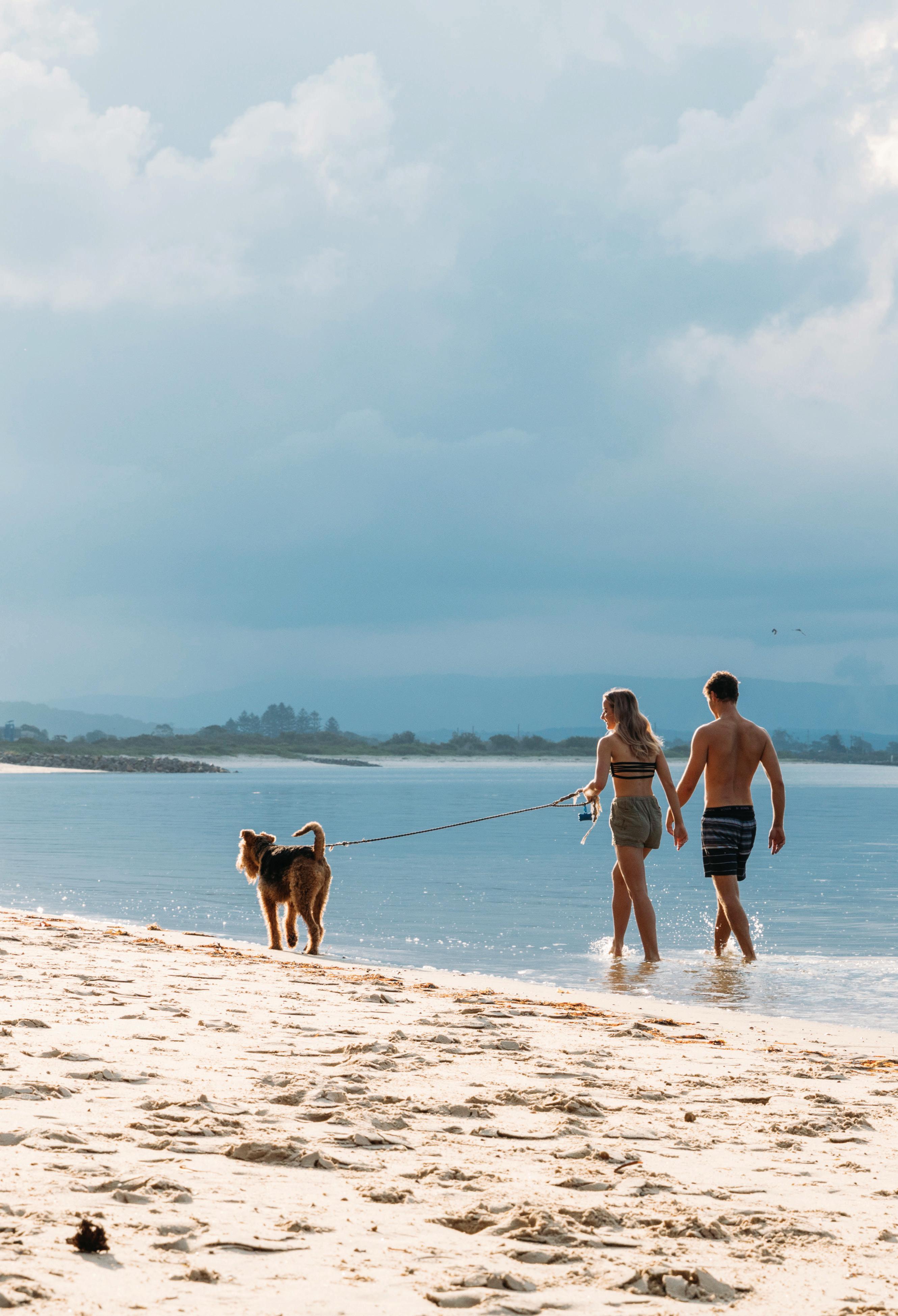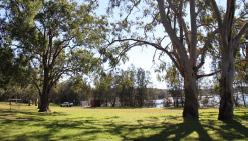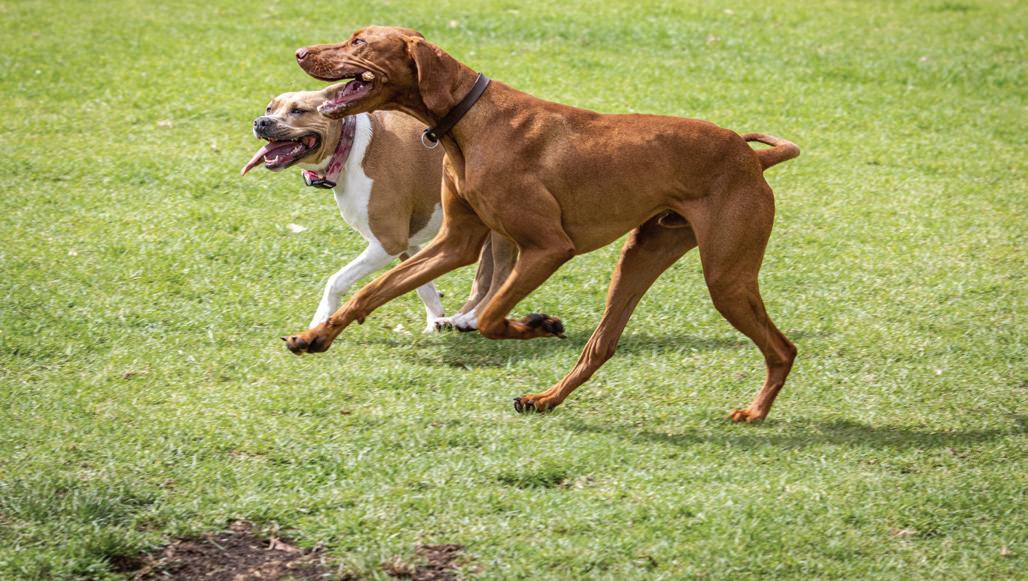
7 minute read
1. Strategy Overview
With 92,336 registered dogs in 2021, Lake Macquarie has one of the highest dog ownership rates in NSW. The increase in dog ownership, together with urban intensification, smaller property sizes and the resulting loss of the traditional large backyard, has reduced residents’ ability to adequately cater to dog’s needs. Subsequently, the demand for public open spaces to provide areas for dogs to exercise and socialise is growing exponentially. The health and wellbeing benefits associated with owning a dog are increasingly being recognised. During the COVID-19 pandemic, ownership levels increased nationally.1 There is a greater community expectation for dog-friendly facilities and spaces in addition to shared access to parks, beaches and bushland areas for dog owners.
The aim of the Dogs in Open Space Strategy is to provide a strategic approach to the provision of dog-friendly spaces that balances the broader needs for safe and accessible open space for all Lake Macquarie residents and visitors.
1.2 What does the strategy Cover?
What is open space?
Community land owned by Council or Crown Land managed by Council.
What is a an off-leash area?

Open space areas that have been designated by Council for dogs to be exercised off-leash. These can be located in parks, beaches, sportsgrounds and other open spaces. They can be fenced for the exclusive use by dogs and their owners, or they can be a shared open space that is also used for other activities. Council currently has 30 off-leash areas throughout the city.
What is an on-leash area?

Open space areas where dogs are permitted on-leash only. Dogs are permitted on-leash in all Council open spaces, unless an area has been declared dog prohibited.
What is a dog prohibited area?
Open space areas where dogs are not permitted on or off-leash. These include areas prescribed under the Companion Animals Act 1988 and those declared by Council to be a dog prohibited area.
All open space managed by Council
Dog off-leash areas, on-leash areas and prohibited areas within open space managed by Council
The strategy does not cover:
National Parks and Wildlife land Crown Land not managed by Council Any other open space not managed by Council
The Dogs in Open Space Strategy is underpinned and informed by a number of volumes or supporting documents including:
Background Report
Includes community and dog profile, literature review, values and trends, existing provision benchmarking and best practice
Community Engagement Report
Findings of the Phase 1 and Phase 2 community and stakeholder consultation Analysis Report
Identifies a provision framework, assesses supply, demand and site suitability, and provides direction for education and regulation
1.3 Where does the Dogs in Open Space Strategy fit?
The Lake Macquarie City Integrated Planning and Reporting Framework supports the Community Strategic Plan, Delivery Program and Operational Plan. The framework includes a suite of integrated and strategic plans that set out a vision, goals, directions and actions to achieve them. It involves a reporting structure to communicate progress to Council and the community, as well as a structured timeline for review to ensure the goals and actions are still relevant. The Dogs in Open Space Strategy would sit within ‘Other Council Strategies and Plans’.

Integrated Planning and Reporting Framework
STATE PLANS AND STRATEGIES RELEVANT REGIONAL PLANS AND PRIORITIES JOINT ORGANISATIONSTATEMENT OF STRATEGIC REGIONAL PRIORITIES
OTHER COUNCIL STRATEGIES AND PLANS
examples include: Disability Inclusion Action Plan Local Strategic Planning Statement Environmental strategies
COMMUNITY STRATEGIC PLAN
COMMUNITY ENGAGEMENT STRATEGY
May include Community Participation Plan
DELIVERY PROGRAM
Four years
OPERATIONAL PLAN
One year Ongoing monitoring and review
RESOURCING STRATEGY Workforce Management Strategy Long-Term Financial Plan Asset Management Strategy and Plan Digital Strategy Plant and Fleet Management Strategy
Ongoing monitoring and review
ANNUAL REPORT

Community Strategic Plan 2022-2032
The Lake Macquarie Community Strategic Plan 2022-2032 was developed in consultation with the community and sets out the city’s vision and community values. The vision and values reflect the priorities of our residents and shape policies and plans prepared by Council, including this strategy. The Dogs in Open Space Strategy aligns with the objectives of three of the seven key focus areas of the Community Strategic Plan.
Local Strategic Planning Statement
The Local Strategic Planning Statement outlines how we will achieve our city vision and uphold our community values through strategic planning. The Dogs in Open Space Strategy aligns with the principles of two of the seven planning priority areas, as shown below.
Community Strategic Plan focus area Local Strategic Planning Statement priority area
UNIQUE LANDSCAPE
• Natural environments are protected and enhanced
PLANNING PRIORITY 6:
A city with a vast natural environment that is valued and protected
• Protect and enhance important biodiversity areas and corridors
CONNECTED COMMUNITIES
• Public spaces help us connect with each other
• We are a supportive and inclusive community
LIFESTYLE AND WELLBEING
• Our open and shared spaces are inclusive and help us live a healthy and safer social life
PLANNING PRIORITY 5:
A city of progress and play where people come together in natural and vibrant public space
• Provide safe, comfortable, social and engaging public spaces that support a variety of uses located within and close to centres, and that are well connected to residential areas
• Enhance community access to sporting, recreational, cultural and community services and facilities
Dogs in Public Open Space Policy
The Dogs in Open Space Strategy has been developed with reference to Council’s Dogs in Public Open Space Policy. This policy provides objectives for dogs in open space and a number of broad policy statements to achieve these objectives. The objectives are: • provide dog owners with access to public open space to exercise their dogs off leash • provide a framework to determine the suitability and provision of open space for dog exercise areas, both fenced and unfenced
• acknowledge the importance of dogs as companion animals and the social and physical benefits for both dog and dog owners in providing dog exercise areas
• ensure the safety of the public and dogs in open space • ensure public recreation and environmental values of open space are retained
NSW Companion Animals Act 1998
The NSW Companion Animals Act 1998 provides for the effective and responsible care and management of companion animals. Under the Act, dogs are required to be under effective control of a competent person 16 years or older and have no more than four dogs in their control.
Dogs are prohibited in the following public places whether they are on-leash or not or otherwise controlled, with the exception of a police dog, assistance animal or corrective services dog: • children’s play areas that are within 10 metres of any playing apparatus • within 10 metres of any food preparation or food consumption spaces not including public pathways • school grounds except with permission of the principal • childcare centres except with permission of the person in control of the centre. Under the Act, councils also have the authority to prohibit dogs from other public spaces including: • recreation spaces including sportsfields where organised games are played • public bathing spaces including beaches • shopping complexes • wildlife protection areas.
Term
Off-leash area
Meaning
Open space where dogs are permitted to be exercised off-leash. These can include dog parks, beach dog off-leash areas and shared dog off-leash areas.
Shared off-leash area Open space where dogs are permitted off-leash within a designated area where other activities may occur. These can include unfenced/partially fenced areas that may have timed/unrestricted access and are shared with other open space uses.
Beach off-leash area Sections of beaches where dogs are permitted off-leash. These spaces are shared with other beach users.
Dog park
On-leash area
Dog prohibited
Plan of Management (PoM)
Natural area
Endangered Ecology Communities (EEC)
Park hierarchy
Exclusive fenced spaces designed just for dogs and their owners with a range of support facilities and complete separation from other park activities.
Open space where dogs are permitted on-leash only.
Open space where dogs are not permitted on or off-leash.
A statutory requirement for community land. PoMs are developed with the community and act as an agreement as to how a place is to be managed and its values protected. They are required for all community land categories of park, sportsground, natural area, general community use and area of cultural significance.
A category of land within a PoM covering community land areas including foreshore, watercourses, bushland, wetlands and escarpments.
EEC are threatened ecological communities of flora and fauna that are endangered due to: • facing a very high risk of extinction in Australia in the near future, as determined in accordance with criteria prescribed by the regulations • are not eligible to be listed as a critically endangered ecological community.
The park hierarchy is identified in Council’s Parks and Play Strategy 2021 and identifies three levels of parks including local, district and regional/major destination.
Local Government Area (LGA)
Local Government Area of Lake Macquarie
Planning catchments Planning catchments are combined suburbs of the LGA that are included in a Development Contributions Plan. There are five planning catchments in the LGA consisting of Belmont (including North Wallarah), Charlestown, Glendale (including Northlakes), Toronto and Morisset (including North Cooranbong VPA).








